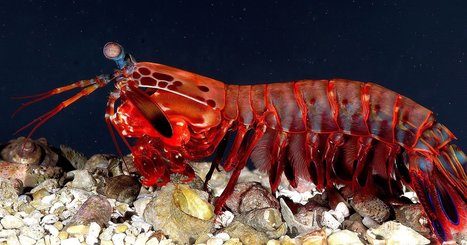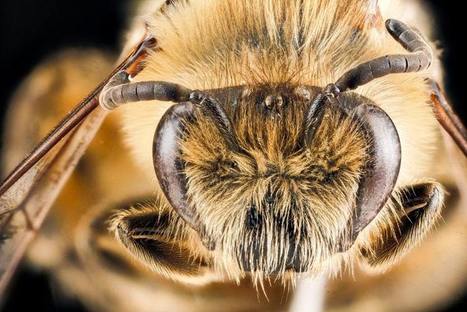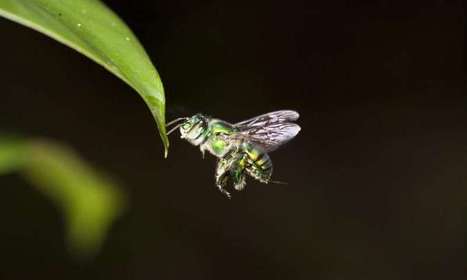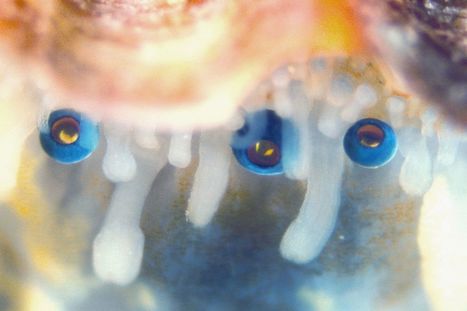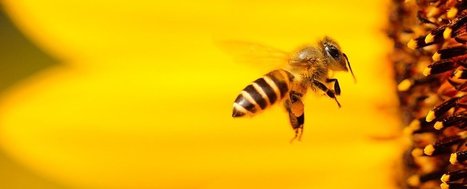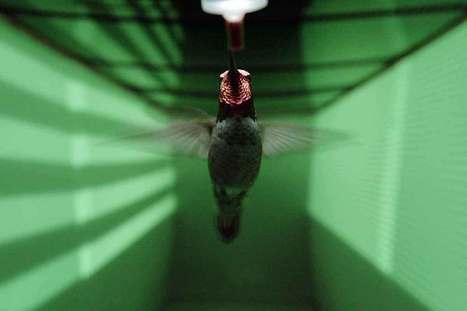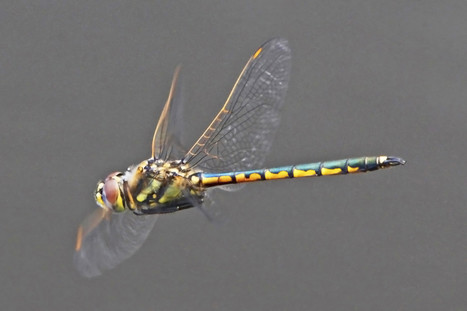 Your new post is loading...
 Your new post is loading...
"Researchers from the University of Illinois have managed to create a new camera called the Mantis Cam that can see polarized light. This technology provides possible solutions for everything from unlocking the mysteries of the underwater world to early cancer detection. The research was published in the journal Optica and takes its inspiration from the mantis shrimp, a crustacean with an incredible visual system. Humans have 3 different types of color receptors, but the mantis shrimp has 16 different receptors alongside another 6 polarization channels. Animals in the underwater world use polarized light for “covert communication channels” as well as hunting and navigation."
"A novel optics system that mimics the structure of a lobster’s eyes would enable a conceptual Explorer-class mission to precisely locate, characterize, and alert other observatories to the source of gravitational waves, which are caused by some of the most powerful events in the universe. [...] the WFI, is equipped with the novel lobster-eye optics, which mimic the structure of the crustacean’s eyes. Lobster eyes are made up of long, narrow cells that each reflect a tiny amount of light from a given direction. This allows the light from a wide viewing area to be focused into a single image."
One area where biomimicry is yielding fascinating results is in the field of optics and machine vision. While our cameras and ways of thinking about sight have largely been informed by the human visual system, cutting-edge research is looking to insects to find new tricks for everything from depth perception to colour analysis.
Combining the best features of a lobster and an African fish, engineers have created an artificial eye that can see in the dark. And their fishy false eyes could help search-and-rescue robots or surgical scopes make dim surroundings seem bright as day.
"After studying how insects navigate through dense vegetation, researchers at Lund University in Sweden have come up with a system that can be applied to flying robots. By adapting the system to drones, they can be made to adjust their speed to their surroundings and fly on their own- completely without human intervention and control. The breakthrough was made by vision researchers Emily Baird and Marie Dacke at the Department of Biology in Lund. Among other things, their research shows how bees that fly through dense forests assess light intensity to avoid other objects and find holes in the vegetation to enable them to navigate safely."
"Hawkmoths are able see in the dark, and now, researchers know how they do it. This ability allows them to track the movements of flowers blowing in the wind, even at night, as the insects hover in the air. Manduca sexta, roughly the size of a hummingbird, were studied by researchers using infrared cameras as they traveled between mechanical flowers. As the team varied light conditions, they also altered the speed at which the artificial flowers swayed from side to side. They then recorded how well the proboscis (feeding probe) of the insects stayed within the target flower. The moths are able to slow down their brains while seeking nectar, improving their eyesight under conditions of low visibility, the study found. While their minds are working on reduced speed, the creatures are also able to maintain rapid flapping of their wings and maintaining complex flight characteristics."
"Shrimps' eyes have been revealed as the latest weapon against cancer, with their unique vision set to be adapted to diagnostic cameras. University of Queensland research has found the shrimps' compound eyes were able to detect polarised light, which could be mimicked to detect cancer cells."
"Entomologists study insects known for their hard exoskeletons, jointed appendages, segmented bodies, bilateral symmetry and antennae. But perhaps the most impressive part of an insect is its lateral compound eyes. Scientists wishing to study insects have over 1 million species to select from! Insect eyes are so impressive scientist and researcher John Rogers of the Science Research Group at Urbana-Champaign, University of Illinois, is designing miniature drones cameras based on their unique design. The big challenge for engineers is to build a drone camera with a 180° range of vision and clear vision throughout that line of sight. Insects have this ability when born."
"The retina is an enormously powerful tool. It sorts through massive amounts of data while operating on only a fraction of the power that a conventional digital camera and computer would require to do the same task. Now, engineers at a company called iniLabs in Switzerland are applying lessons from biology in an effort to build a more efficient digital camera inspired by the human retina."
Using the compound eyes of the humble moth as their inspiration, an international team of physicists has developed new nanoscale materials that could someday reduce the radiation dosages received by patients getting X-rayed, while improving the resolution of the resulting images.
"Scientists from the Max Planck Institute of Colloids have looked to nature to develop a relatively simple and inexpensive method of producing calcium carbonate lenses packed together in a regular arrangement. The researchers took inspiration from the brittle star (Ophiocoma wendtii), which is studded with tiny crystalline lenses made of calcium carbonate, that together form a type of compound eye."
|
Scallops, hardly the most complex of creatures, have intricate eyes that work like telescopes, say researchers. They hope this discovery can one day help us make our own telescopes more powerful.
"New research on how bees perceive colour could be put to good use in our digital cameras, meaning photos shot by drones or phones would look more natural than ever. It's all to do with colour constancy, the way that bees (and humans) can tell a flower is red no matter what the colour or quality of the light – a mental trick that the digital cameras of today really struggle with."
"Hummingbirds have a unique collision avoidance system built into their brains that allows them to perform high-speed aerobatics in safety. The super-agile birds, whose wings beat up to 70 times a second, can hover, fly backwards, and whizz through dense vegetation at more than 50 kilometres per hour. How they manage to avoid potentially fatal crashes has remained a mystery until now. Researchers in Canada conducted a series of experiments which showed that the birds process visual information differently from other animals. As they dart and dive at speed, they judge distance from the way looming objects appear to get bigger, and vice versa."
Bees control their flight using the speed of motion (optic flow) of the visual world around them. A study by Scientists at the University of Sheffield Department of Computer Science suggests how motion-direction detecting circuits could be wired together to also detect motion-speed, which is crucial for controlling bees’ flight.
“Honeybees are excellent navigators and explorers, using vision extensively in these tasks, despite having a brain of only one million neurons,” said Alex Cope, PhD., lead researcher on the paper. “Understanding how bees avoid walls, and what information they can use to navigate, moves us closer to the development of efficient algorithms for navigation and routing, which would greatly enhance the performance of autonomous flying robotics,” he added.
"Researchers have developed an artificial-intelligence system based on a dragonfly’s vision that they say could aid the blind and help create a better driverless car. [...] In the latest research, published in the Journal of the Royal Society Interface, scientists showed how a computer program can mimic the eyesight of a dragonfly. Compared with humans, dragonflies have a limited ability to distinguish details and shapes of objects. But they are one of the insect kingdom’s best predators because their wide field of vision and ability to detect fast movements allow them to keep track of prey even among a swarm of insects."
"PenTile® technology is biomimetic, meaning it is designed to compliment the complex mechanics of the eye-brain system. As a simple example of eye mechanics consider how the eye utilizes the color blue. The eye has cone receptors that sense color and brightness, and discern patterns. These cones are sensitive to different wavelengths of color—primarily red, green, and blue. The blue cones detect mostly color (chroma) information, while the red and green cones do most of the work resolving images by discerning luminance, edges, and structural details of images, as well as contributing to color vision. The red and green cones are used independently, each cone seeing a "dot" of black and white—ignoring its color to produce high resolution luminance perception—and are used in opposition, comparing the amount of red versus green, to produce low resolution color perception. The PenTile RGBW™ layout uses each red, green, blue and white subpixel to present high-resolution luminance information to the red and green cones, while using the combined effect of all the color subpixels to present lower-resolution chroma (color) information to all three cone types. Combined, this optimizes the match of display technology to the biological mechanisms of human vision." Photo details: Brown eyes, 2007 by Alecgarci 149. Licensed under Public Domain via Wikimedia Commons.
"New research conducted by marine biologists reveals that the mantis shrimp Haptosquilla trispinosa uses a unique color vision system. [...] «Modern cameras struggle with the amount of data they take in due to increased pixel numbers. Maybe there is a more efficient way and the bio-inspiration provided by the shrimp could be the answer», Ms Thoen [lead author of study] concluded."
"One example of biomimicry that keeps popping up on the pages of Gizmag is the use of insect eyes as a model for innovative new optical devices. It seems that the potential for development in this area is far from exhausted with the announcement of another bug-inspired lens breakthrough from Ohio State University. This experimental lens developed by associate professor of biomedical engineering and ophthalmology, Yi Zhao, combines the wide angle properties of insect vision with the depth-of-field capabilities of a human eye."
Drawing heavily upon nature for inspiration, a team of researchers has created a new artificial lens that is nearly identical to the natural lens of the human eye. This innovative lens, which is made up of thousands of nanoscale polymer layers, may one day provide a more natural performance in implantable lenses to replace damaged or diseased human eye lenses, as well as consumer vision products; it also may lead to superior ground and aerial surveillance technology.
"A technology that mimics the structure of a lobster's eyes is now being applied to a new instrument that could help revolutionize X-ray astronomy and keep astronauts safe on the International Space Station."
"Arnold Glas has developed Ornilux, a spider-web inspired glass that reduces bird strikes into windows by an estimated 75 percent."
|
 Your new post is loading...
Your new post is loading...
 Your new post is loading...
Your new post is loading...




